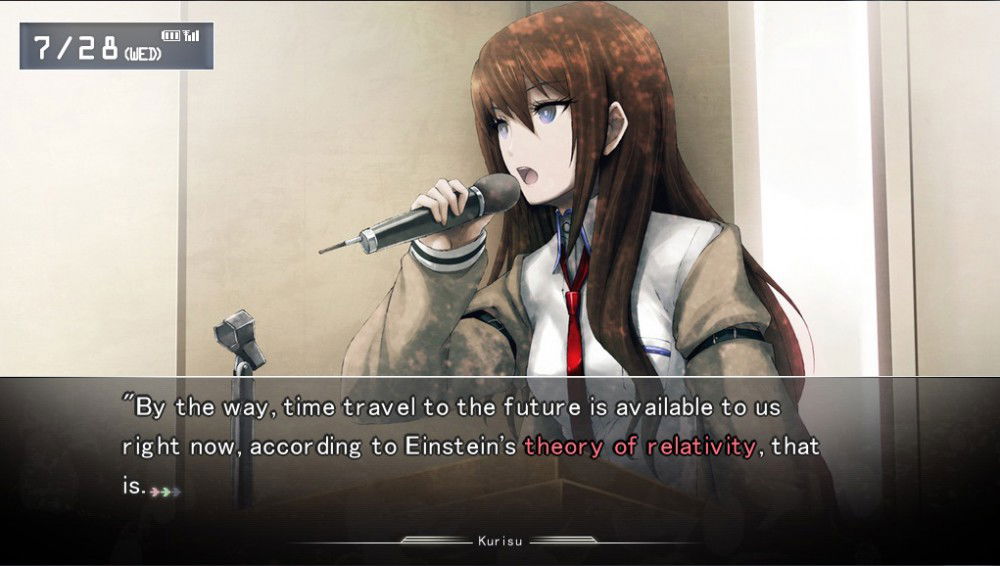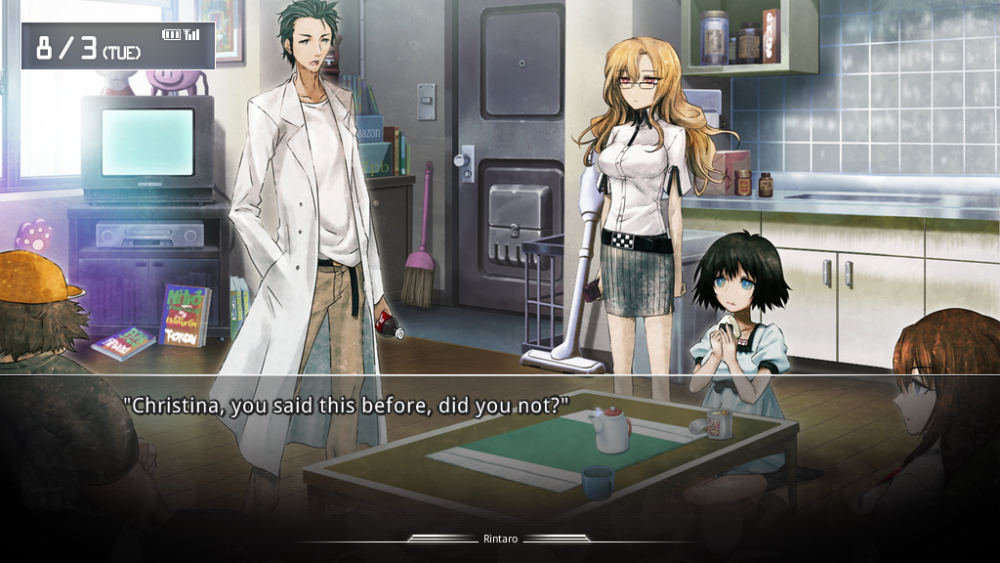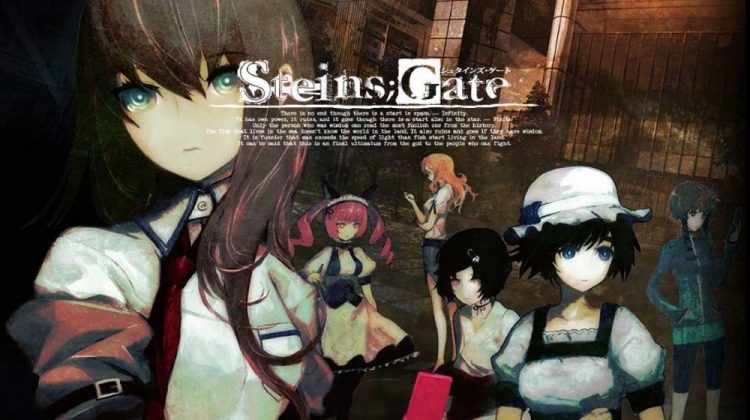Steins;Gate is, hands down, my favorite anime of all-time and while I have seen some amazing shows, none of which were able to topple Steins;Gate off that #1 spot. Despite this being my favorite anime, I had never played the Visual Novel on which the anime was based off of… until now. Thanks to the wonderful people over at 5pb., I was able to experience the story once again, but not without some twists and turns! Today, I take a look at Steins;Gate the Visual Novel! It should be noted that while this is available for multiple platforms, I played the Steam version on PC.
Title: Steins;Gate
Platform: North America: PC (Reviewed) | Japan: PC, PS3, PSP, Playstation Vita
Developer: 5pb. Nitroplus
Publisher: North America: 5pb. | Japan: 5pb. (PC), Nitroplus (PC), PQube (PS3/Vita), Mages (PSP)
Release Date: October 15, 2009 (Original) | September 8, 2016 (US Steam Release)
Price: $34.99
Unless you are an anime fan, you may or may not have a grasp on what a Visual Novel video game is. It is exactly what is sounds like: A novel. So what fun is there in reading a book on your television screen? Despite the fact that this is just an interactive e-book for your console of choice, it brings you into the world of Japanese story telling. The visuals in the game are rather stunning and look like paintings more than anything. There is voice work in the game, but it is in the original Japanese audio, but since you’re reading along, it doesn’t really affect you all that much.
So what is the story of Steins;Gate? Let’s take a look at that!
Steins;Gate takes place in Akihabara, Japan above a small CRT Television repair/chop shop. This small apartment is known as the Future Gadget Laboratory. Okabe Rintaro (Okarin for short) is the founder of the Future Gadget Lab and their purpose is to invent new things; however, most of the time, these new inventions don’t exactly pan out very well. Okarin also considers himself to be a mad scientist and goes by the alias Hououin Kyoma. He’s constantly paranoid about this “organization” interfering in the world and how he is constantly being watched by them.
During one of their experiments with hooking a cell phone up to a microwave, they were able to turn a banana into a green gel-like substance, but they soon discover that a simple gel-ified banana was only the beginning to their biggest discovery. They realized that the banana was trying to travel through time and ending up in that state each time it attempts to do so. This leads them to believe that physical matter cannot time travel, but electrical impulses might be able to accomplish this feat. They test this theory by sending text messages into the past (referred to as D-Mails), and lo and behold, things start to change little by little.
Steins;Gate does something very few stories about time travel do… and that’s introduce us to the concept that while there is a past, present, and future, that simply changing something in the past doesn’t really affect the future. Instead, it creates an alternate world line in which everything is the same except for that one thing that has changed. This wouldn’t be the first time, however, a show did something like this. In fact, back in the 80s, Back to the Future II did this with the alternate 1985 timeline. The same principle is being applied here in Steins;Gate that if you change one thing, you’re creating different/alternate world lines rather than changing the future.
Once the gang at the lab figures this out, they begin to wonder if they can change a world line so much that everything remains the same, yet everything changes at the same time. They call this world line the Steins;Gate and their goal is to eventually reach that world line, however, there is one little problem when it comes to that goal: nobody, except for Okarin, realizes that the world lines have shifted.
This is because Okarin has an inherent ability known as the Reading Steiner. When a world line changes, he’s the only person that is able to sense it while everyone else that he knows is completely oblivious to the change. Because he realizes this; and based on the fact that electrical impulses can get sent through time, he volunteers himself to hook his mind up to the cell phone microphone to transfer his conscience through time to these different world lines in order to fix them because they begin to realize that things are changing WAY too much. What those events are, I will allow them to remain shrouded in mystery to avoid any potential spoilers.

The “gameplay” here in Steins;Gate centers around Okarin’s cell phone. At certain points, you are given choices as to who to send a “D-Mail” to. These choices could have little to no effect on your progress, or they could end up changing the game so much that you could end up with a completely different ending. This form of gameplay in Japan is known as routing. This is what makes Visual Novels so replayable. To go through and experience each and every route is akin to going through and getting a 100% completion in an RPG. You’ll spend hours upon hours doing everything possible to get everything and that’s no different here.
The thing about Steins;Gate is that the story is so well-crated and interesting, that you don’t mind playing through the visual novel several times to get that ending. The engagement that the story brings to the player is really high and there are enough twists and turns to keep you wanting to come back. Of course, once you are about to make the choice, you could save your game, make the choice, reload and make another choice and save that on a separate file. This way you could play and experience each branch of the story, only having to complete it once, but I wouldn’t really recommend that as you could easily end up getting lost or getting the story lines crossed over or confused with one another.

One thing that differs between the Visual Novel and the anime is Okarin himself. In the Visual Novel, Okarin has several lines of dialogue that are considered to be his inner monologue. He did not have any of that in the anime and here, it makes a HUGE difference to your experience with the story. These inner monologues give us a glimpse into Okarin’s mind and it shows just how aware he is of everything that is going on around him. You don’t really get that sense in the anime as most of the time you are simply looking at Okarin being a complete and total goofball.
Here in the Visual Novel, you get to see Okarin’s mindset. You get to experience the pain of the decisions he has to make once the story hits the dramatic turning point. It is through Okarin’s inner monologues that you, the player, start to feel a connection to, not only Okarin, but to the choices YOU have to make. Sending a D-Mail no longer becomes a simple task of choice. You become aware of that the consequences of your actions could change everything you will experience in the game from that moment on and, most importantly, change the characters you’ve grown attached to.

There are a lot of characters in the show. Some of them seem like simple background supporting characters, but they become much bigger and much more important than what they lead on to be later on down the road.
In addition to Okarin, we have Mayuri, who is Okarin’s childhood friend, Daru the “Super Hacker,” Kurisu Makise, who is a young researcher who is interested in time travel, Moeka, a soft-spoken girl who prefers to communicate through text messages and Suzuha, who is a part-time worker in the CRT show below owned by Mr. Braun, just to name a few. Each character has their own backstory that is well-crafted and those backstories set up some amazing plot turns later on down the road. Some that you could probably guess and others that will hit you like a truck from of left field. Their stories are not only interesting, but they are crafted in such a way where they make you feel attached to the character. That attachment correlates to your decisions in sending D-Mails and can actually affect your decisions.
All in all, Steins;Gate is a Visual Novel that should be experienced by everyone at least once. Even if you have seen the anime, the Visual Novel is much more fleshed out and it has reignited my love for this series. After experiencing a story like this, it is no wonder why people heralded the anime as one of the best of all-time. To think that the Visual Novel is better than that truly shows why Steins;Gate is simply a masterpiece.
*This game was provided to The Outerhaven Productions for review purposes. You can find additional information about our review policy here.
Steins;Gate
Overall
Steins;Gate is one of those stories that comes around once in a blue moon. Its amazing hook factor coupled with its well fleshed out and engaging characters makes this one of the best science fiction stories of the modern era.
-
Took long enough to get here but was worth it


